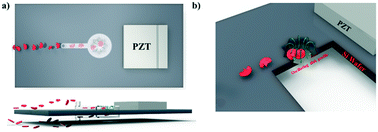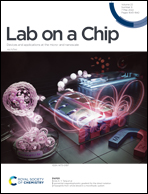A star shaped acoustofluidic mixer enhances rapid malaria diagnostics via cell lysis and whole blood homogenisation in 2 seconds†
Abstract
Malaria is a life-threatening disease caused by a parasite, which can be transmitted to humans through bites of infected female Anopheles mosquitoes. This disease plagues a significant population of the world, necessitating the need for better diagnostic platforms to enhance the detection sensitivity, whilst reducing processing times, sample volumes and cost. A critical step in achieving improved detection is the effective lysis of blood samples. Here, we propose the use of an acoustically actuated microfluidic mixer for enhanced blood cell lysis. Guided by numerical simulations, we experimentally demonstrate that the device is capable of lysing a 20× dilution of isolated red blood cells (RBCs) with an efficiency of ∼95% within 350 ms (0.1 mL). Further, experimental results show that the device can effectively lyse whole blood irrespective of its dilution factor. Compared to the conventional method of using water, this platform is capable of releasing a larger quantity of haemoglobin into plasma, increasing the efficiency without the need for lysis reagents. The lysis efficiency was validated with malaria infected whole blood samples, resulting in an improved sensitivity as compared to the unlysed infected samples. Partial least squares-regression (PLS-R) analysis exhibits cross-validated R2 values of 0.959 and 0.98 from unlysed and device lysed spectral datasets, respectively. Critically, as expected, the root mean square error of cross validation (RMSECV) value was significantly reduced in the acoustically lysed datasets (RMSECV of 0.97), indicating the improved quantification of parasitic infections compared to unlysed datasets (RMSECV of 1.48). High lysis efficiency and ultrafast processing of very small sample volumes makes the combined acoustofluidic/spectroscopic approach extremely attractive for point-of-care blood diagnosis, especially for detection of neonatal and congenital malaria in babies, for whom a heel prick is often the only option for blood collection.

- This article is part of the themed collection: Miniaturised Sensors & Diagnostics


 Please wait while we load your content...
Please wait while we load your content...